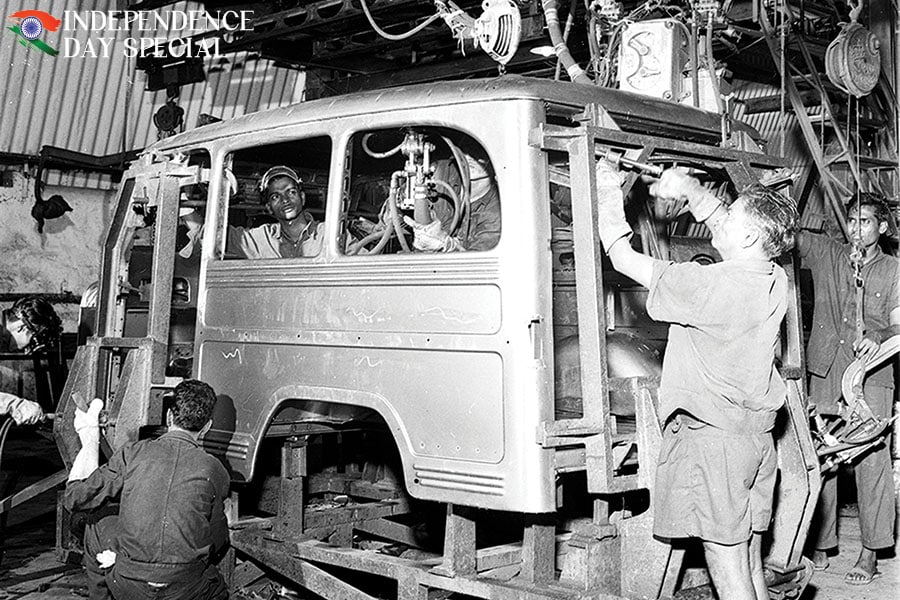How Tata Motors and Mahindra are leading India's SUV rush
Both Tata Motors and Mahindra started only a month apart, have gone on to become one of the world's best-known automobile companies, and now they are giving a much-needed push to the country's auto sector
 Mahindra & Mahindra International Harvester machines, August 1961
Image: Mitter Bedi
Mahindra & Mahindra International Harvester machines, August 1961
Image: Mitter Bedi
They perhaps rate among the foremost pivots in India’s corporate annals.
But, at the end of it all, both Tata Motors and Mahindra, which started only a month apart from each other, have gone on to become two of the world’s best-known auto companies, with legacies spread as far as the United Kingdom and South Korea.
By 1949, Mahindra began importing the legendary Willys Jeep and assembling them out of their factory in Mumbai. Only a few years before that, Mahindra’s partner, Mohammed, had moved to Pakistan after the Partition to become the country’s finance minister, prompting Mahindra to acquire his stake.
 Tata Motors, though, started out manufacturing locomotives and boilers, then in high demand, before realising the enormous opportunity in heavy engineering products as the world began to rebuild itself after World War II. In 1954, it struck a partnership with Germany’s Daimler-Benz to manufacture trucks in India. “We derailed the locos and got on the track with trucks. After that, we never looked back,” Sumant Moolgaokar, the famed CEO of Tata Motors, says in Beyond The Last Blue Mountain, written by RM Lala.
Tata Motors, though, started out manufacturing locomotives and boilers, then in high demand, before realising the enormous opportunity in heavy engineering products as the world began to rebuild itself after World War II. In 1954, it struck a partnership with Germany’s Daimler-Benz to manufacture trucks in India. “We derailed the locos and got on the track with trucks. After that, we never looked back,” Sumant Moolgaokar, the famed CEO of Tata Motors, says in Beyond The Last Blue Mountain, written by RM Lala.Since then, the two automakers have tasted enormous success, and seen pitiable falls, before emerging stronger, especially in the last few years. Today, one is the country’s third-largest car maker while the other is the fourth. Together, both are also driving the pivot into the electric vehicle (EV) market with a slew of launches over the next few months. Already, Tata Motors is India’s largest EV maker with a market share of over 70 percent. On the commercial vehicle side, while Tata Motors holds the top spot, Mahindra follows a close second.
“I think one of the big strengths of Tata Motors has been its people who have seen this as an opportunity to succeed and be a winner,” Shailesh Chandra, managing director of Tata Motors Passenger Vehicles Ltd, told Forbes India early this year. “The pace at which we are coming up with different kinds of products is unlikely of a company that was once losing money. Not only have we done it fast, but we have also done it very frugally.”
Mahindra, too, has undergone a sea of transformation in the last few years, with a focus on what it calls authentic SUVs, after spreading itself too thin with models that perhaps were only SUVs by name. But a much-needed transition has seen it bring out wildly successful models such as Thar and XUV 700, leaping it to the fourth largest car maker in India.
Also read: Tata Motors: Moving on from the Nano
“By picking on our capability and competence, we want to attract consumers who are looking at multiple other segments,” Rajesh Jejurikar, executive director and CEO (auto and farm sector) at Mahindra & Mahindra, had told Forbes India. “You can be a specialised position brand and still get volumes. To win in the SUV battle, you don’t have to make a product that’s similar to what somebody else is making. Because that’s what works for them. We must focus on our strengths. And that’s exactly the tweaking that we’ve done.”
Tata and Mahindra will once again shake up the country’s automobile industry with their launches—Tata with the Curvv, a coupe SUV that will be the first in its segment, and Mahindra with the Thar Roxx, a five-door version of its popular SUV, Thar. Both head-turners are likely to give India’s auto sector a much-needed boost as sales have seen a slowdown in recent months.
All that means Mahindra and Tata Motors have come a long way from 1945. And as with the India story, where questions have often been raised about its future and survival, both have survived and thrived. With global brands such as Jaguar Land Rover and Pininfarina respectively under their belt, Tata Motors and Mahindra are now busy writing the next chapter of their story.
(This story appears in the 23 August, 2024 issue of Forbes India. To visit our Archives, click here.)


















